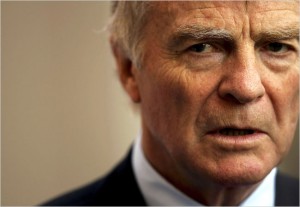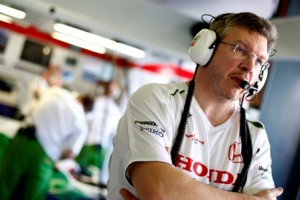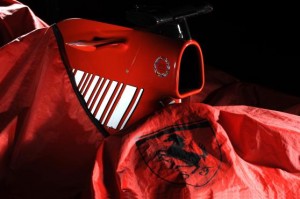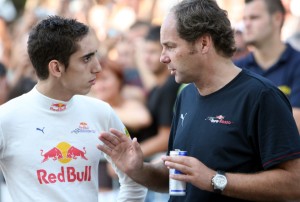 It seems Pedro de la Rosa still has ambitions for an F1 race seat. The 37-year-old Spanish driver has been in Formula One since starting as a test driver with Jordan in 1998. Since then he has driven for Arrows and Jaguar before joining McLaren as test driver in 2003. He is one of the few drivers to have scored points in his debut Grand Prix and he finished in second place behind Jenson Button at the eventful 2006 Hungarian Grand Prix.
It seems Pedro de la Rosa still has ambitions for an F1 race seat. The 37-year-old Spanish driver has been in Formula One since starting as a test driver with Jordan in 1998. Since then he has driven for Arrows and Jaguar before joining McLaren as test driver in 2003. He is one of the few drivers to have scored points in his debut Grand Prix and he finished in second place behind Jenson Button at the eventful 2006 Hungarian Grand Prix.
Speaking at the Autosport International show in Birmingham, de la Rosa said:
At the moment, at my age, if I put one step in a different category I know that my chances of getting back into a full race drive are very slim.
So I have to be with the best, I have to test with the best, and become a more intelligent and complete test driver.
So thats my only chance to come back, but for sure I will come back.
Is it too late for Pedro? He is the same age as David Coulthard who retired at the end of last season and with Lewis Hamilton taking Alonso’s record to become the youngest ever Formula One Champion at age 23 F1 seems to be more and more a young man’s game. Sebastien Vettel is only 21 (and looks about 15). Even Rubens Barrichello is younger than de la Rosa.
I admire Pedro for keeping the dream alive. I think he is a good driver and has put in some impressive performances when he has had to step into the McLaren on race day. I would like to see him with a permanent race seat. But that being said I can’t really see it happening. There comes a time when if you haven’t made it by now you’re not going to.
It could be that de la Rosa is just better as a test driver than as a race driver and this is where Ron Dennis thinks he can be of most value to the team. I think we need to look at the test driver role not as simply a stepping stone to a full race seat but as a vital team role that takes as much, if somewhat different, skill as a race driver. Just like the safety car driver is an important role that has its own unique demands.
Unfortunately safety car drivers and test drivers don’t get the same salary as race drivers and if in his heart Pedro still wants a race seat then he is probably right that if he sets foot outside of Formula One he will never get back in again.
 FIA president Max Mosley has written a letter to FOTA chairman Luca di Montezemolo outlining his thoughts on the “really big changes” required in 2010 to ensure the survival of the Formula One Championship. The full letter is here and it makes for some interesting reading.
FIA president Max Mosley has written a letter to FOTA chairman Luca di Montezemolo outlining his thoughts on the “really big changes” required in 2010 to ensure the survival of the Formula One Championship. The full letter is here and it makes for some interesting reading.
A standard gearbox and underbody is proposed for 2010 and the FIA will shortly produce a list of chassis parts and systems which will be the only elements of the chassis which can be developed. All remaining chassis elements will be either standard or frozen.
Mosley also wants to discuss the use of KERS and how it can be developed without incurring significant costs for the teams. KERS has been a controversial addition to the 2009 regulations with teams spending huge sums developing the devices and it is not known how many teams will acutally use the device when the championship begins in two months. There are two different kinds of KERS devices: one that stores electrical energy using batteries and capacitors and one that uses a flywheel to store kinetic energy. Most teams have opted to develop an electrical device but in the letter Mosley suggests that these will be banned in future:
We are increasingly of the view that the use of chemical storage (in particular batteries) should be prohibited in Formula One owing to the unsuitability of the batteries currently available. There are at least two mechanical or electro-mechanical systems under development for Formula One and there may be others as well as hydraulic systems. Formula One would benefit from systems with more capacity than the present 400KJ, 60KW, (for example maxima of: 2MJ stored, 150KW in, 100KW out) but still very small and very light, as is essential in Formula One. These figures are theoretically possible with mechanical devices, but not feasible in the foreseeable future using batteries and/or capacitors. Such non-chemical devices, if successfully developed, would have a very significant impact on road transport and other applications.
Mosley also mentions such radical ideas as reversed grids, allocating leading grid places by lot, giving the World Championship to the driver with most wins and so on but rightly points out that once a faster car gets in front it tends to drive away.
In the letter he also says:
there is no rational argument to support the continued use in Formula One of expensive technologies which have no relevance outside the sport and are unknown (and thus of no interest) to the general public.
I think he makes some good points. Standardising components that most people don’t care about (or may not even be aware of) makes sense but F1 should be the pinacle of motor racing. It should showcase not just the best drivers but also the best engineers and technology. While reducing the engine rev limt to 17,000 should provide cost savings and I doubt we will notice the drop in revs care must be taken when messing with such a vital part of a racing car as the engine. I don’t care if all the cars have the same underbody and I don’t really mind if they all use the same gearbox but there still needs to be some scope for the engineers to make a difference. It’s not just the drivers that are competing on Sunday it’s also the pit crew, the team managers and the car designers.
 Ross Brawn, Team Principal of Honda, has said he is “really optimistic” about the chances of the team finding a buyer by the end of the month. Speaking to Italian paper La Gazzetta dello Sport, he also said Honda have approached Ferrari about the possibility of them supplying engines for the team in 2009.
Ross Brawn, Team Principal of Honda, has said he is “really optimistic” about the chances of the team finding a buyer by the end of the month. Speaking to Italian paper La Gazzetta dello Sport, he also said Honda have approached Ferrari about the possibility of them supplying engines for the team in 2009.
But while other teams are preparing to launch their 2009 cars in the coming weeks, Honda faces “at least six weeks of work” integrating whatever engine they decide to go with. Honda have already said they will not supply the team with engines in 2009. So once again, even if Honda survive to race in 2009, it will be another “transitional” season for the team. Brawn said:
We are studying a package of evolutions for 2010, when we aim to step up the ladder. Next year will remain for us a transitional one.
How many years does the loyal Jenson Button have to wait to get a car deserving of his talents? It was clear early last year that Honda’s RA108 just wasn’t fast enough but with Ross Brawn signing on and the 2009 reboot of the rules I was hoping Honda (and Jenson in particular) could be competetive in 2009. Unfortunately it seems like Button’s career will be put on hold for another year. Bernie Ecclestone thinks he should hold out for a seat in a top team:
He should be in any of the top teams. I’d rather see him wait to get a seat in one of those than race in an uncompetitive car.
He might not have a choice.
 Ferrari will be the first to reveal their 2009 car on Monday 12 January when Felipe Massa will drive it round the Ferrari test track at Fiorano. Although Ferrari will be first to launch their car it won’t be in legal race spec for the opening Grand Prix in Australia on 29 March. Ferrari have been having issues with their KERS development and it is still unclear whether they will start the season with the device or introduce it later in the year.
Ferrari will be the first to reveal their 2009 car on Monday 12 January when Felipe Massa will drive it round the Ferrari test track at Fiorano. Although Ferrari will be first to launch their car it won’t be in legal race spec for the opening Grand Prix in Australia on 29 March. Ferrari have been having issues with their KERS development and it is still unclear whether they will start the season with the device or introduce it later in the year.
This kicks of a busy couple of weeks of car releases from most of the other teams. Toyota is next on 15 January, closely followed by McLaren a day later then Williams and Renault on 19 January. BMW will release their car on 20 January while Red Bull has chosen to wait until 9 February to launch their car. This should allow Mark Webber time to recover fully from his broken leg before testing the car.
There are still no official dates for Force India and Toro Rosso but it is expected they will appear in early March. Both teams are dependent on technology from other constructors; Toro Rosso from it’s sister team Red Bull and Force India is using a Mercedes Benz engine and will run with a KERS system and other parts supplied by McLaren, including a full gearbox and hydraulic system.
As for Honda, they continue to develop their 2009 car but unless a buyer can be found soon it’s unlikely we’ll see them on the grid in Melbourne.
 There’s still no official word from Toro Rosso about who will be driving for them in 2009 but in speaking to the Blick newspaper in Sweden Gerhard Berger said: “For 2009 Toro Rosso has a good and fast driver in Buemi.”
There’s still no official word from Toro Rosso about who will be driving for them in 2009 but in speaking to the Blick newspaper in Sweden Gerhard Berger said: “For 2009 Toro Rosso has a good and fast driver in Buemi.”
Berger is no longer a part owner of Toro Rosso having sold his fifty percent stake in the team back to Red Bull but we can assume he is still pretty close to the team. Does this mean the Swiss driver will soon be confirmed at Toro Rosso and if so who will his team mate be? Sebastien Bourdais had some bad luck in 2008 and didn’t really get the results he deserved but as I said before I hope we get to see Takuma Sato in F1 again this year.
 It seems Pedro de la Rosa still has ambitions for an F1 race seat. The 37-year-old Spanish driver has been in Formula One since starting as a test driver with Jordan in 1998. Since then he has driven for Arrows and Jaguar before joining McLaren as test driver in 2003. He is one of the few drivers to have scored points in his debut Grand Prix and he finished in second place behind Jenson Button at the eventful 2006 Hungarian Grand Prix.
It seems Pedro de la Rosa still has ambitions for an F1 race seat. The 37-year-old Spanish driver has been in Formula One since starting as a test driver with Jordan in 1998. Since then he has driven for Arrows and Jaguar before joining McLaren as test driver in 2003. He is one of the few drivers to have scored points in his debut Grand Prix and he finished in second place behind Jenson Button at the eventful 2006 Hungarian Grand Prix. FIA president Max Mosley has written a letter to FOTA chairman Luca di Montezemolo outlining his thoughts on the “really big changes” required in 2010 to ensure the survival of the Formula One Championship. The full letter is
FIA president Max Mosley has written a letter to FOTA chairman Luca di Montezemolo outlining his thoughts on the “really big changes” required in 2010 to ensure the survival of the Formula One Championship. The full letter is  Ross Brawn, Team Principal of Honda, has said he is “really optimistic” about the chances of the team finding a buyer by the end of the month. Speaking to Italian paper La Gazzetta dello Sport, he also said Honda have approached Ferrari about the possibility of them supplying engines for the team in 2009.
Ross Brawn, Team Principal of Honda, has said he is “really optimistic” about the chances of the team finding a buyer by the end of the month. Speaking to Italian paper La Gazzetta dello Sport, he also said Honda have approached Ferrari about the possibility of them supplying engines for the team in 2009. Ferrari will be the first to reveal their 2009 car on Monday 12 January when Felipe Massa will drive it round the Ferrari test track at Fiorano. Although Ferrari will be first to launch their car it won’t be in legal race spec for the opening Grand Prix in Australia on 29 March. Ferrari have been having issues with their KERS development and it is still unclear whether they will start the season with the device or introduce it later in the year.
Ferrari will be the first to reveal their 2009 car on Monday 12 January when Felipe Massa will drive it round the Ferrari test track at Fiorano. Although Ferrari will be first to launch their car it won’t be in legal race spec for the opening Grand Prix in Australia on 29 March. Ferrari have been having issues with their KERS development and it is still unclear whether they will start the season with the device or introduce it later in the year. There’s still no official word from Toro Rosso about who will be driving for them in 2009 but in speaking to the Blick newspaper in Sweden Gerhard Berger said: “For 2009 Toro Rosso has a good and fast driver in Buemi.”
There’s still no official word from Toro Rosso about who will be driving for them in 2009 but in speaking to the Blick newspaper in Sweden Gerhard Berger said: “For 2009 Toro Rosso has a good and fast driver in Buemi.”